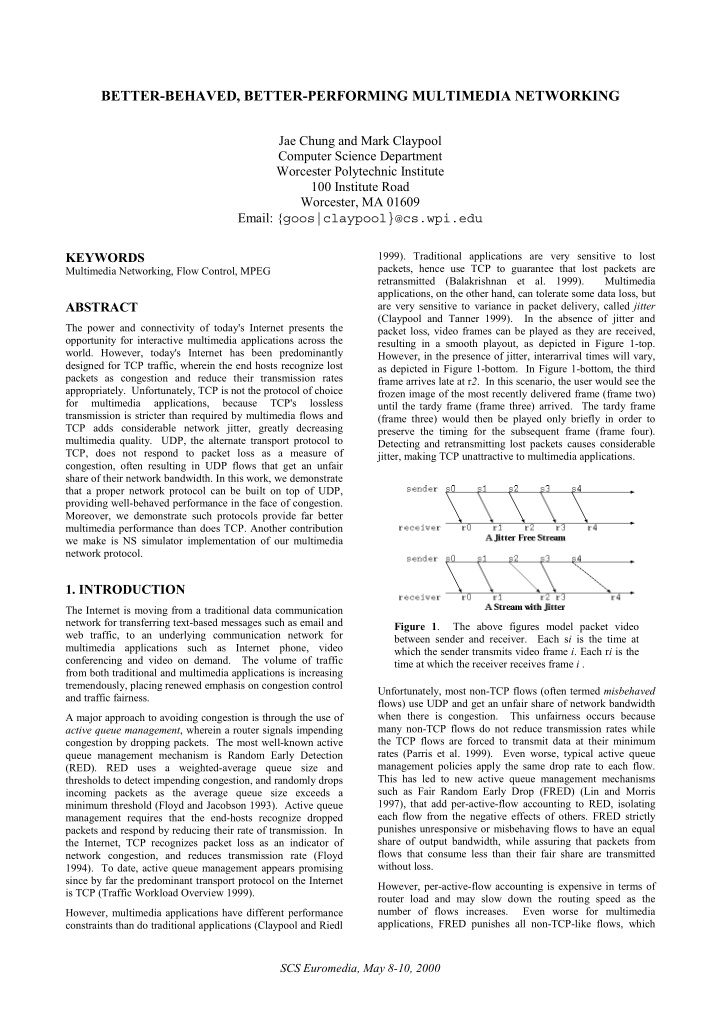



BETTER-BEHAVED, BETTER-PERFORMING MULTIMEDIA NETWORKING Jae Chung and Mark Claypool Computer Science Department Worcester Polytechnic Institute 100 Institute Road Worcester, MA 01609 Email: { goos|claypool}@cs.wpi.edu KEYWORDS 1999). Traditional applications are very sensitive to lost packets, hence use TCP to guarantee that lost packets are Multimedia Networking, Flow Control, MPEG retransmitted (Balakrishnan et al. 1999). Multimedia applications, on the other hand, can tolerate some data loss, but ABSTRACT are very sensitive to variance in packet delivery, called jitter (Claypool and Tanner 1999). In the absence of jitter and The power and connectivity of today's Internet presents the packet loss, video frames can be played as they are received, opportunity for interactive multimedia applications across the resulting in a smooth playout, as depicted in Figure 1-top. world. However, today's Internet has been predominantly However, in the presence of jitter, interarrival times will vary, designed for TCP traffic, wherein the end hosts recognize lost as depicted in Figure 1-bottom. In Figure 1-bottom, the third packets as congestion and reduce their transmission rates frame arrives late at r 2 . In this scenario, the user would see the appropriately. Unfortunately, TCP is not the protocol of choice frozen image of the most recently delivered frame (frame two) for multimedia applications, because TCP's lossless until the tardy frame (frame three) arrived. The tardy frame transmission is stricter than required by multimedia flows and (frame three) would then be played only briefly in order to TCP adds considerable network jitter, greatly decreasing preserve the timing for the subsequent frame (frame four). multimedia quality. UDP, the alternate transport protocol to Detecting and retransmitting lost packets causes considerable TCP, does not respond to packet loss as a measure of jitter, making TCP unattractive to multimedia applications. congestion, often resulting in UDP flows that get an unfair share of their network bandwidth. In this work, we demonstrate that a proper network protocol can be built on top of UDP, providing well-behaved performance in the face of congestion. Moreover, we demonstrate such protocols provide far better multimedia performance than does TCP. Another contribution we make is NS simulator implementation of our multimedia network protocol. 1. INTRODUCTION The Internet is moving from a traditional data communication network for transferring text-based messages such as email and Figure 1 . The above figures model packet video web traffic, to an underlying communication network for between sender and receiver. Each s i is the time at multimedia applications such as Internet phone, video which the sender transmits video frame i . Each r i is the conferencing and video on demand. The volume of traffic time at which the receiver receives frame i . from both traditional and multimedia applications is increasing tremendously, placing renewed emphasis on congestion control Unfortunately, most non-TCP flows (often termed misbehaved and traffic fairness. flows) use UDP and get an unfair share of network bandwidth when there is congestion. This unfairness occurs because A major approach to avoiding congestion is through the use of many non-TCP flows do not reduce transmission rates while active queue management , wherein a router signals impending the TCP flows are forced to transmit data at their minimum congestion by dropping packets. The most well-known active rates (Parris et al. 1999). Even worse, typical active queue queue management mechanism is Random Early Detection management policies apply the same drop rate to each flow. (RED). RED uses a weighted-average queue size and This has led to new active queue management mechanisms thresholds to detect impending congestion, and randomly drops such as Fair Random Early Drop (FRED) (Lin and Morris incoming packets as the average queue size exceeds a 1997), that add per-active-flow accounting to RED, isolating minimum threshold (Floyd and Jacobson 1993). Active queue each flow from the negative effects of others. FRED strictly management requires that the end-hosts recognize dropped punishes unresponsive or misbehaving flows to have an equal packets and respond by reducing their rate of transmission. In share of output bandwidth, while assuring that packets from the Internet, TCP recognizes packet loss as an indicator of flows that consume less than their fair share are transmitted network congestion, and reduces transmission rate (Floyd without loss. 1994). To date, active queue management appears promising since by far the predominant transport protocol on the Internet However, per-active-flow accounting is expensive in terms of is TCP (Traffic Workload Overview 1999). router load and may slow down the routing speed as the number of flows increases. Even worse for multimedia However, multimedia applications have different performance applications, FRED punishes all non-TCP-like flows, which constraints than do traditional applications (Claypool and Riedl SCS Euromedia, May 8-10, 2000
Recommend
More recommend